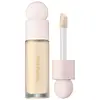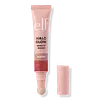What's inside
What's inside
 Key Ingredients
Key Ingredients

 Benefits
Benefits

 Concerns
Concerns

 Ingredients Side-by-side
Ingredients Side-by-side

Water
Skin ConditioningDimethicone
EmollientHydrogenated Didecene
Skin ConditioningCetyl PEG/PPG-10/1 Dimethicone
EmulsifyingPropanediol
SolventGlycerin
HumectantAcrylates/Polytrimethylsiloxymethacrylate Copolymer
Skin ConditioningBoron Nitride
AbsorbentPolyglyceryl-4 Isostearate
EmulsifyingTrimethylsiloxysilicate
EmollientIsododecane
EmollientDisodium Stearoyl Glutamate
CleansingDisteardimonium Hectorite
StabilisingHydroxyacetophenone
AntioxidantOryza Sativa Bran Wax
Skin ConditioningSodium Chloride
MaskingDimethicone Crosspolymer
Emulsion StabilisingHelianthus Annuus Seed Oil
EmollientCaprylyl Glycol
Emollient1,2-Hexanediol
Skin ConditioningPhenyl Trimethicone
Skin ConditioningTocopheryl Acetate
AntioxidantAluminum Hydroxide
EmollientTrisodium Ethylenediamine Disuccinate
Dimethiconol
EmollientDecyl Glucoside
CleansingGardenia Florida Fruit Extract
Skin ConditioningHexylene Glycol
EmulsifyingNelumbo Nucifera Flower Extract
Skin ConditioningNymphaea Odorata Root Extract
RefreshingPhenoxyethanol
PreservativeCI 77891
Cosmetic ColorantIron Oxides
Water, Dimethicone, Hydrogenated Didecene, Cetyl PEG/PPG-10/1 Dimethicone, Propanediol, Glycerin, Acrylates/Polytrimethylsiloxymethacrylate Copolymer, Boron Nitride, Polyglyceryl-4 Isostearate, Trimethylsiloxysilicate, Isododecane, Disodium Stearoyl Glutamate, Disteardimonium Hectorite, Hydroxyacetophenone, Oryza Sativa Bran Wax, Sodium Chloride, Dimethicone Crosspolymer, Helianthus Annuus Seed Oil, Caprylyl Glycol, 1,2-Hexanediol, Phenyl Trimethicone, Tocopheryl Acetate, Aluminum Hydroxide, Trisodium Ethylenediamine Disuccinate, Dimethiconol, Decyl Glucoside, Gardenia Florida Fruit Extract, Hexylene Glycol, Nelumbo Nucifera Flower Extract, Nymphaea Odorata Root Extract, Phenoxyethanol, CI 77891, Iron Oxides
Water
Skin ConditioningHydrogenated Didecene
Skin ConditioningIsododecane
EmollientSynthetic Fluorphlogopite
Glycerin
HumectantPropylene Glycol
HumectantPEG-10 Dimethicone
Skin ConditioningTrimethylsiloxysilicate
EmollientSqualane
EmollientCetyl PEG/PPG-10/1 Dimethicone
EmulsifyingDimethicone
EmollientIsoamyl Laurate
EmollientHydrogenated Styrene/Isoprene Copolymer
Mica
Cosmetic ColorantSodium Chloride
MaskingSynthetic Sapphire
Caprylic/Capric Triglyceride
MaskingPolyglyceryl-4 Isostearate
EmulsifyingPropylene Carbonate
SolventDisteardimonium Hectorite
StabilisingTocopherol
AntioxidantHelianthus Annuus Seed Oil
EmollientCalendula Officinalis Flower Extract
MaskingPolymethylsilsesquioxane
Hydrolyzed Sodium Hyaluronate
Skin ConditioningSodium Hyaluronate
HumectantDisodium EDTA
Triethoxycaprylylsilane
Caprylyl Glycol
EmollientPhenoxyethanol
PreservativeEthylhexylglycerin
Skin ConditioningPentaerythrityl Tetra-Di-T-Butyl Hydroxyhydrocinnamate
AntioxidantTin Oxide
AbrasiveCI 77891
Cosmetic ColorantCI 16035
Cosmetic ColorantWater, Hydrogenated Didecene, Isododecane, Synthetic Fluorphlogopite, Glycerin, Propylene Glycol, PEG-10 Dimethicone, Trimethylsiloxysilicate, Squalane, Cetyl PEG/PPG-10/1 Dimethicone, Dimethicone, Isoamyl Laurate, Hydrogenated Styrene/Isoprene Copolymer, Mica, Sodium Chloride, Synthetic Sapphire, Caprylic/Capric Triglyceride, Polyglyceryl-4 Isostearate, Propylene Carbonate, Disteardimonium Hectorite, Tocopherol, Helianthus Annuus Seed Oil, Calendula Officinalis Flower Extract, Polymethylsilsesquioxane, Hydrolyzed Sodium Hyaluronate, Sodium Hyaluronate, Disodium EDTA, Triethoxycaprylylsilane, Caprylyl Glycol, Phenoxyethanol, Ethylhexylglycerin, Pentaerythrityl Tetra-Di-T-Butyl Hydroxyhydrocinnamate, Tin Oxide, CI 77891, CI 16035
 Reviews
Reviews

Ingredients Explained
These ingredients are found in both products.
Ingredients higher up in an ingredient list are typically present in a larger amount.
Caprylyl Glycol is a humectant and emollient, meaning it attracts and preserves moisture.
It is a common ingredient in many products, especially those designed to hydrate skin. The primary benefits are retaining moisture, skin softening, and promoting a healthy skin barrier.
Though Caprylyl Glycol is an alcohol derived from fatty acids, it is not the kind that can dry out skin.
This ingredient is also used as a preservative to extend the life of products. It has slight antimicrobial properties.
Learn more about Caprylyl GlycolThis ingredient is a high molecular weight silicone. It has emulsifying and skin conditioning properties.
Ci 77891 is a white pigment from Titanium dioxide. It is naturally found in minerals such as rutile and ilmenite.
It's main function is to add a white color to cosmetics. It can also be mixed with other colors to create different shades.
Ci 77891 is commonly found in sunscreens due to its ability to block UV rays.
Learn more about CI 77891Dimethicone is a type of synthetic silicone created from natural materials such as quartz.
What it does:
Dimethicone comes in different viscosities:
Depending on the viscosity, dimethicone has different properties.
Ingredients lists don't always show which type is used, so we recommend reaching out to the brand if you have questions about the viscosity.
This ingredient is unlikely to cause irritation because it does not get absorbed into skin. However, people with silicone allergies should be careful about using this ingredient.
Note: Dimethicone may contribute to pilling. This is because it is not oil or water soluble, so pilling may occur when layered with products. When mixed with heavy oils in a formula, the outcome is also quite greasy.
Learn more about DimethiconeDisteardimonium Hectorite comes from the clay mineral named hectorite. It is used to add thickness to a product.
It can also help stabilize a product by helping to disperse other ingredients.
Hectorite is a rare, white clay mineral.
Learn more about Disteardimonium HectoriteGlycerin is already naturally found in your skin. It helps moisturize and protect your skin.
A study from 2016 found glycerin to be more effective as a humectant than AHAs and hyaluronic acid.
As a humectant, it helps the skin stay hydrated by pulling moisture to your skin. The low molecular weight of glycerin allows it to pull moisture into the deeper layers of your skin.
Hydrated skin improves your skin barrier; Your skin barrier helps protect against irritants and bacteria.
Glycerin has also been found to have antimicrobial and antiviral properties. Due to these properties, glycerin is often used in wound and burn treatments.
In cosmetics, glycerin is usually derived from plants such as soybean or palm. However, it can also be sourced from animals, such as tallow or animal fat.
This ingredient is organic, colorless, odorless, and non-toxic.
Glycerin is the name for this ingredient in American English. British English uses Glycerol/Glycerine.
Learn more about GlycerinHelianthus Annuus Seed Oil is the oil derived from the seeds of a Sunflower. Sunflower seed oil is non-fragrant. It is an emollient, meaning it helps to soften the skin.
Sunflower seed oil contains many fatty acids. The fatty acids found in sunflower seeds include (from highest amount to least): linoleic acid, myristic acid, palmitic acid, stearic acid, arachidic acid, oleic acid, and linolenic acid.
These fatty acids help the skin create ceramides. Ceramides play a role in repairing the skin barrier.
Helianthus Annuus Seed Oil helps moisturize the skin. This in turn helps the skin look more rejuvenated and smoother.
Sunflowers are rich in vitamin E.
Historians believe Indigenous cultures of North America domesticated sunflowers before corn. Thus they relied on sunflower oil for a variety of uses. One such use is moisturizing skin and hair.
Sunflower seed oil may not be fungal acne safe. We recommend speaking with a professional if you have any concerns.
Learn more about Helianthus Annuus Seed OilWe don't have a description for Hydrogenated Didecene yet.
Isododecane is a fragrance, emollient, and solvent.
As an emollient, it helps your skin stay soft and hydrated. Emollients help trap moisture into your skin.
Isododecane's role as a solvent makes it a great texture enhancer. It spreads smoothly on skin and does not leave a sticky feeling behind. Isododecane also helps prevent color transfer in makeup products.
Isododecane is not absorbed into skin.
Learn more about IsododecanePhenoxyethanol is a preservative that has germicide, antimicrobial, and aromatic properties. Studies show that phenoxyethanol can prevent microbial growth. By itself, it has a scent that is similar to that of a rose.
It's often used in formulations along with Caprylyl Glycol to preserve the shelf life of products.
This ingredient is an emulsifer and stabilizer. It comes from isostearic acid and polyglycerin.
As an emulsifier, it helps blend oil and water to improve texture, spreadbility, and application.
Due to it being derived from isostearic acid, this ingredient may not be fungal acne safe.
Learn more about Polyglyceryl-4 IsostearateChances are, you eat sodium chloride every day. Sodium Chloride is also known as table salt.
This ingredient has many purposes in skincare: thickener, emulsifier, and exfoliator.
You'll most likely find this ingredient in cleansers where it is used to create a gel-like texture. As an emulsifier, it also prevents ingredients from separating.
There is much debate on whether this ingredient is comedogenic. The short answer - comedogenic ratings don't tell the whole story. Learn more about comegodenic ratings here.
The concensus about this ingredient causing acne seems to be divided. Research is needed to understand if this ingredient does cause acne.
Scrubs may use salt as the primary exfoliating ingredient.
Learn more about Sodium ChlorideThis silicone is an emollient. Emollients create a thin film on the skin to prevent moisture from escaping.
It is not soluble in water and helps increase water-resistance in products.
According to a manufacturer, it can blend seamlessly with silicone oils, such as Cyclopentasiloxane.
Learn more about TrimethylsiloxysilicateWater. It's the most common cosmetic ingredient of all. You'll usually see it at the top of ingredient lists, meaning that it makes up the largest part of the product.
So why is it so popular? Water most often acts as a solvent - this means that it helps dissolve other ingredients into the formulation.
You'll also recognize water as that liquid we all need to stay alive. If you see this, drink a glass of water. Stay hydrated!
Learn more about Water